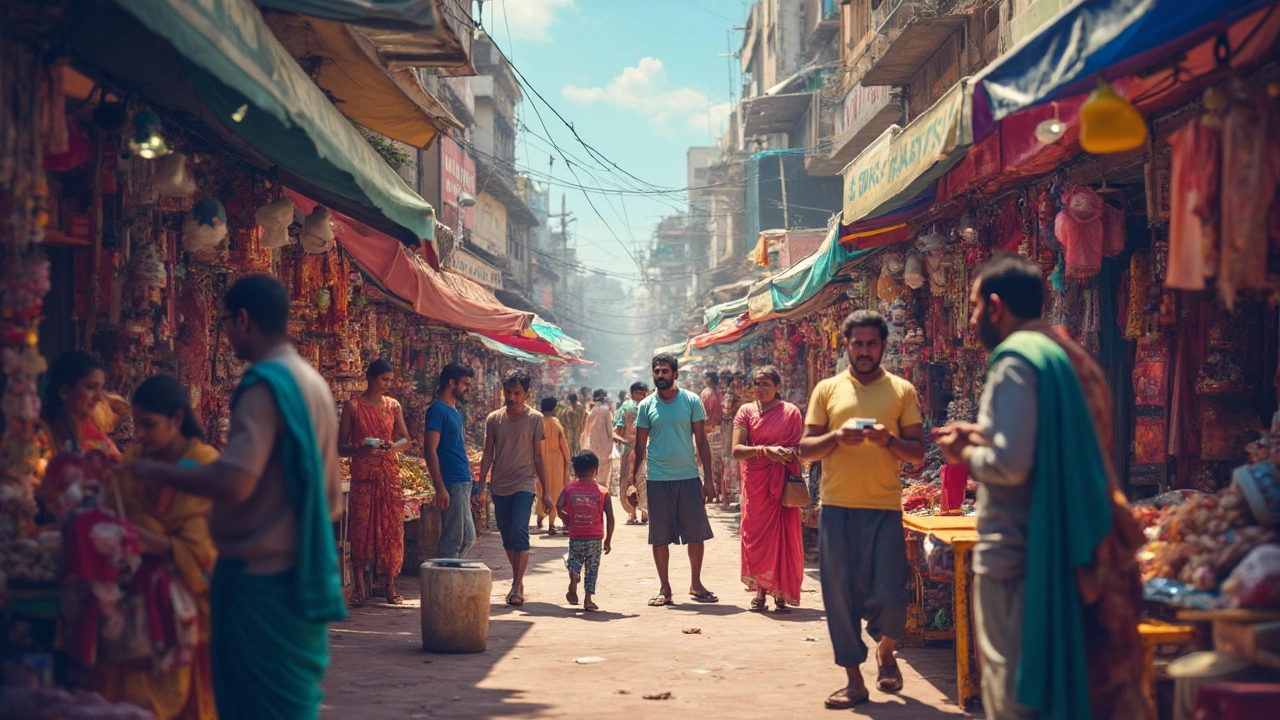India's e-commerce scene is nothing short of a digital fiesta. This space has been growing at a lightning pace, and if numbers tickle your fancy, there are currently over 20,000 e-commerce websites buzzing with action here. Why so many, you ask? Well, India isn't just a country—it's a diverse universe of shoppers, and every e-commerce platform tries to cater to unique segments and preferences.
You've got the giants like Amazon and Flipkart leading the pack, but they're sharing the stage with smaller, more niche players who focus on specific product categories or regional markets. Ever thought of buying ethnic wear straight from a designer in Jaipur or getting exotic spices delivered from Kerala? There's a site for that, and probably dozens more.
- E-commerce Explosion in India
- Major E-commerce Players
- Growing Trends in Digital Shopping
- Unique Features of Indian E-commerce Platforms
- Challenges and Opportunities
- Tips for Entering the Indian E-commerce Market
E-commerce Explosion in India
India's e-commerce market is like a rocket that just won't stop soaring. Thanks to increased internet access and affordable smartphones, millions more are hopping online every year, transforming how Indians shop for everything from groceries to gadgets. That's why this country has become the fastest-growing e-commerce market in the world.
Back in 2014, India's e-commerce sales were just a whisper at around $14 billion. Fast forward to today, and you're looking at over $100 billion. This isn't just a fluke—it's a trend fueled by a huge young population tech-savvy and hungry for convenience.
Most of the action happens in urban areas, but rural areas aren't far behind. Internet penetration has reached these regions too, opening new doors for sellers and buyers who, until recently, were shut out of the traditional retail scene. The top movers and shakers like Amazon and Flipkart have invested big bucks setting up logistics networks, ensuring that products reach even the most remote corners of India.
Sure, the giants have their share of the pie, but don’t ignore the rise of home-grown platforms. Sites like Snapdeal, Myntra, and BigBasket not only cater to mass markets but also tap into niche segments, showing that local flavor can compete with global giants. Check this out, though: unique platforms focused on specialized sectors like fashion, groceries, and electronics alone count in the thousands.
In 2021, the transition to digital formats due to the COVID-19 pandemic added more fuel to the fire. More shoppers and sellers turned online, making digital transactions not just convenient but necessary.
| Year | Market Size (Billion USD) |
|---|---|
| 2014 | 14 |
| 2025 (Projected) | 200 |
So, what's the secret sauce here? Quick adaptation to digital tools, a cultural shift towards online shopping, and a robust ecosystem that includes payment gateways, delivery logistics, and customer support. Keep an eye on India’s e-commerce—it’s not just expanding, it’s revolutionizing shopping altogether.
Major E-commerce Players
When you're talking about e-commerce in India, two names usually pop up right away: Amazon and Flipkart. These guys aren't just dabbling; they're dominating. Amazon entered the Indian market in 2013 and has since become a household name, offering everything from electronics to groceries. Meanwhile, Flipkart, an Indian-born company, started back in 2007 and quickly rose to become a top contender, eventually being acquired by Walmart in 2018.
But don't think it's just a two-horse race. There's also Reliance’s JioMart, which is challenging the big players with its own set of strategies, like integrating physical stores with online sales. Then you have Myntra and Ajio, both strong contenders in the fashion segment, making sure Indians are always stylish.
India's e-commerce scene wouldn't be complete without mentioning niche players like BigBasket in groceries, Nykaa in beauty products, and Zomato when you're craving a bite. These platforms have not only made a name for themselves but have also deeply influenced consumer habits.
If you're looking at numbers to wrap your head around this growth, here's a quick snapshot:
| Platform | Founded | Primary Segment |
|---|---|---|
| Amazon India | 2013 | Everything Store |
| Flipkart | 2007 | General Retail |
| Myntra | 2007 | Fashion |
| Nykaa | 2012 | Beauty |
| BigBasket | 2011 | Groceries |
| Zomato | 2008 | Food Delivery |
The diversity in the Indian market means these platforms have to keep innovating to stay relevant. From offering unique services like cash-on-delivery to creating localized apps, they're doing whatever it takes to capture the hearts and wallets of India's enormous, varied audience.
Growing Trends in Digital Shopping
India's e-commerce world is constantly changing, and some pretty cool trends are making waves. One major shift folks are noticing is the surge in mobile shopping. With more than 600 million smartphone users, it's no surprise that mobile shopping is the go-to for many. People love the convenience of buying anytime, anywhere with just a tap.
Then there's the whole social commerce scene. You know how everyone and their grandma are on WhatsApp and Instagram? Well, businesses are catching on, using these platforms to sell directly. It's like shopping while you're scrolling through memes—super easy!
Another big trend is the rise of regional and niche marketplaces. Smaller brands focusing on local crafts or specific interests are finding their audience online. Shoppers are digging this because they get unique products while supporting local communities.
Let's not forget the focus on sustainable products. More and more people are looking for eco-friendly options, and businesses that offer sustainable products are seeing a bump in interest. It's a win-win for the planet and conscious shoppers.
Key Trends in Indian E-commerce
- Mobile Commerce Dominance: Over 70% of sales are happening via mobile devices.
- Social Commerce Growth: A mix of shopping and social media interactions is becoming the norm.
- Niche and Regional Platforms: Catering to local needs and interests with specific marketplaces.
- Sustainable Shopping: A rise in eco-conscious buying behavior among consumers.
As Indian e-commerce keeps growing, these trends are shaping how people shop and businesses sell. For anyone interested in jumping into this market, riding these waves is crucial for success.

Unique Features of Indian E-commerce Platforms
India's e-commerce platforms are a kaleidoscope of unique features that cater to the diverse needs and preferences of the Indian shopper. What's cool about these platforms is how they integrate local culture and shopping habits into their operations. It's not just about buying things; it's about experiencing shopping in an Indian way.
One standout feature is the cash-on-delivery (COD) option, which is incredibly popular in India. Unlike many Western countries where digital payments are the norm, COD remains a preferred payment method here, accounting for about 60% of online transactions. This indicates a trust factor and the cultural preference for paying once the product is in hand.
A focus on language diversity is another unique aspect. Many e-commerce India sites offer multilingual support to cater to the vast array of languages spoken across the country. Platforms like Snapdeal and Flipkart have interfaces in multiple languages, making shopping accessible to non-English speakers.
Personalization takes center stage on Indian platforms. They often use data analytics to understand local consumer preferences and offer customized recommendations. This isn't just about what you've shopped for before; it's about predicting what you might want next, and it's done with impressive precision.
Indian marketplaces also boast unique product listings that you might not find elsewhere. Products range from traditional crafts and regional specialties to locally sourced organic food items, ensuring that there's something for everyone and encouraging local artisans and businesses to thrive online.
Customer service in Indian e-commerce is tailored to provide a more personalized touch. Many platforms offer 24/7 customer support with regional language options, ensuring that help is always at hand, no matter where you're from.
Challenges and Opportunities
Diving into the Indian e-commerce scene is like stepping into a bustling bazaar. The big question is, how do you stand out among over 20,000 e-commerce platforms in India? There are plenty of hurdles, but where there's a challenge, there's also a chance to shine.
First, the logistics of reaching every nook and cranny in a country as expansive as India can be a bit tricky. Delivery infrastructure isn't as developed in rural areas, and this can lead to delays or higher costs—talk about needing creativity and reliability!
Payment options are another puzzle. While digital payments are on the rise, cash on delivery still rules in many parts. Clever platforms need to offer a mix of payment methods to keep everyone happy.
Then there's customization. Indians shop distinctly, with regional differences in style, taste, and even language. Successful e-commerce India sites are those that personalize the shopping experience to cater to these varied needs, often leveraging AI for more targeted marketing.
Now, let's chat about the flip side—the opportunities. With millions of potential customers hopping online every year, there's a massive untapped market. Everyone from fashion boutiques to artisanal handicraft sellers can find an eager audience.
Another big draw? The festive shopping seasons—events like Diwali and Holi see a surge in online purchases. Tapping into these periods with promotions or exclusive products can lead to huge successes.
Lastly, leveraging mobile growth is a smart move. A large chunk of buyers are ditching desktops for smartphones. Crafting a seamless mobile shopping experience can skyrocket customer satisfaction and retention.
Tips for Entering the Indian E-commerce Market
Diving into India’s vibrant online shopping world can feel a bit like jumping into an ocean—but don’t worry, you’ve got this! Here are a few tips to navigate the e-commerce India landscape effectively.
First off, understand your audience. India is culturally diverse—not just by region but by language, tradition, and taste. Tailor your products and marketing to fit the unique needs of different groups. A one-size-fits-all strategy? Probably not your best bet here.
Next up, focus on mobile optimization. With over 70% of online shopping happening via mobile devices, make sure your platform is mobile-friendly. Quick loading times and easy navigation are crucial. Plus, think about offering app-based services. Having a dedicated app could boost your engagement significantly.
Payment methods in India are a big deal. Offer a variety of options—like credit/debit cards, UPI, digital wallets, and cash on delivery. Many Indians still prefer cash payments due to familiarity, despite the digital push.
Shipping and logistics can make or break your business here. Partner with reliable logistics providers who understand the local terrain—literally and figuratively. Offering a quick and hassle-free return policy can also win you loyal customers.
Finally, don’t underestimate the power of social media marketing. Platforms like Instagram and Facebook are buzzing with potential customers. Engaging content, influencer partnerships, and regional language ads can boost your reach and sales. Pay attention to trends and don’t hesitate to get creative!
If you’re just getting started, a little competitive analysis goes a long way. Study what established players are doing, what’s working for them, and what’s not. You can glean valuable insights that’ll shape your strategy.

